From the moment I first laid eyes on a Rainbowfish, I knew they were something special. These radiant creatures, belonging to the family Melanotaeniidae, are truly one of nature’s masterpieces. With over 50 species, Rainbowfish are renowned for their dazzling colors that stretch across the color spectrum. Typically adorned with radiant hues of blue, red, orange, and yellow, the colors of these fish can change with their mood, time of day, and overall health.
The beauty of Rainbowfish is not only skin deep; these fish are also known for their peaceful demeanor and active lifestyle. As a lover of these aquatic beauties, I can attest that watching them dart around in their vibrant schools is a sight to behold. Moreover, their compatibility with other species makes them an excellent choice for community aquariums.
Many varieties of Rainbowfish are commonly found both in the wild and in the pet trade. However, certain species may be considered rare or endangered, often due to factors like habitat loss or pollution. In the world of aquariums, rarity can sometimes be a badge of honor, but it also serves as a reminder of our role in preserving these stunning creatures.
Rainbowfish, native to freshwater habitats like streams, rivers, and lakes in Australia, New Guinea, and nearby islands, are primarily mid-dwelling fish. However, they are not strictly bound to this zone and can be found at different levels of the water column. This adaptability is a testament to their resilience and one of the many reasons they make such fascinating aquarium inhabitants.
When it comes to diet, Rainbowfish are not fussy eaters. They are omnivorous and thrive on a varied diet of small crustaceans, insects, algae, and plant matter. In captivity, a balanced diet of high-quality flake food, live food, and frozen food will keep them happy and healthy.
Rainbowfish are sociable creatures. They prefer to be kept in groups and are known for their peaceful and active behavior. This sociability extends beyond their own species; they typically get along well with other peaceful fish, making them excellent community tank members.
With their alluring colors, fascinating behavior, and relatively straightforward care requirements, Rainbowfish are an excellent choice for both beginner and experienced aquarists. Whether you’re an amateur hobbyist or a seasoned fishkeeper, you’re bound to fall in love with these vibrant swimmers. So, are you ready to join the ranks of Rainbowfish enthusiasts? Dive in, and let’s learn more about caring for these aquatic jewels.
Table of Contents
Understanding Rainbowfish: Price and Variants
Rainbowfish are a popular choice for aquarium enthusiasts due to their vibrant colors and peaceful nature. Here’s a detailed look at their price, common names in the market, and variants:
Price
The cost of Rainbowfish can vary significantly depending on the species, size, coloration, and availability. On average, you can expect to pay anywhere from $5 to $20 per fish for the most common species. However, rarer species or those with particularly striking coloration can cost significantly more. It’s important to purchase Rainbowfish from reputable sellers to ensure you’re getting healthy, well-cared-for fish.
Variants
There are over 50 species in the Rainbowfish family, each with its own unique coloration and characteristics. Some of the most popular variants include:
Melanotaenia boesemani (Boeseman’s Rainbowfish)
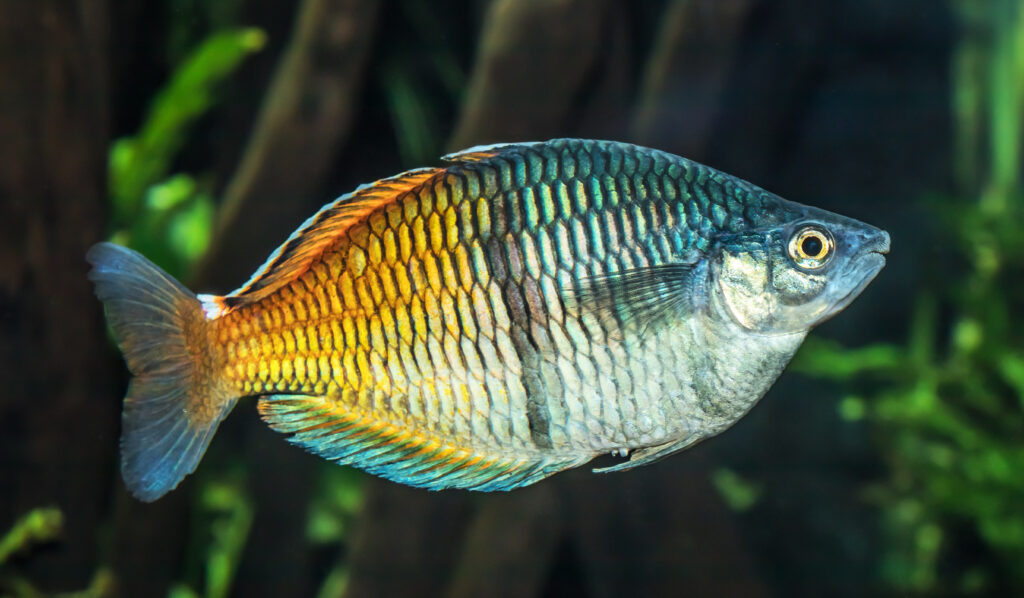
Known for its unique two-tone coloration, with the front half of the body typically a bluish-gray and the back half a vibrant orange or yellow.
Melanotaenia lacustris (Lake Kutubu Rainbowfish)
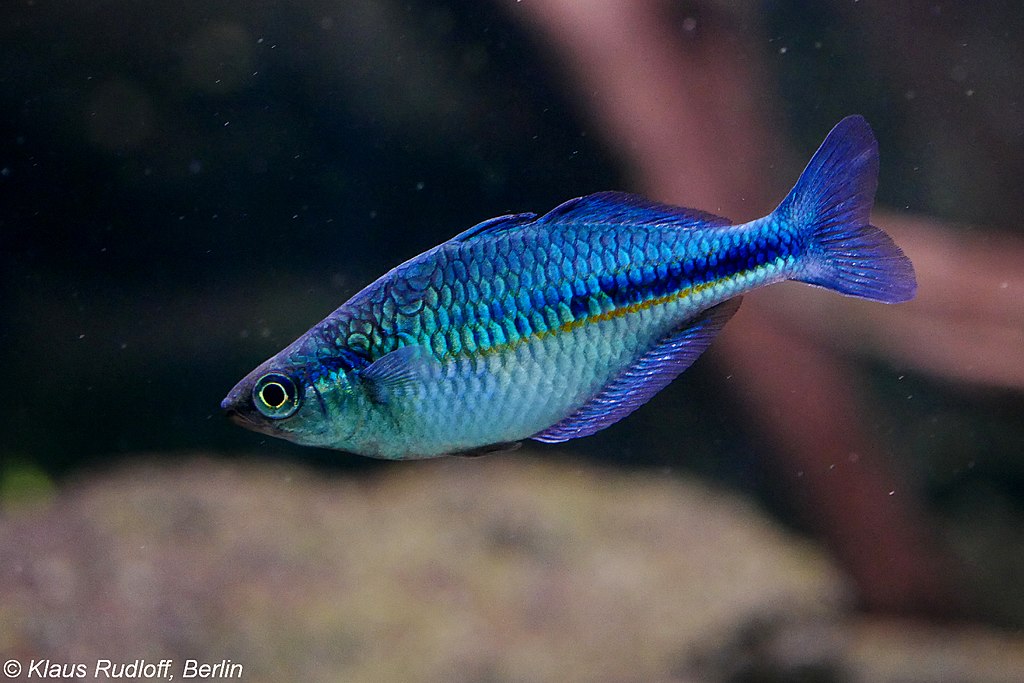
Named after its native habitat, Lake Kutubu in Papua New Guinea, this species is also known as the Turquoise Rainbowfish due to its stunning blue-green coloration.
Melanotaenia praecox (Dwarf Neon Rainbowfish)
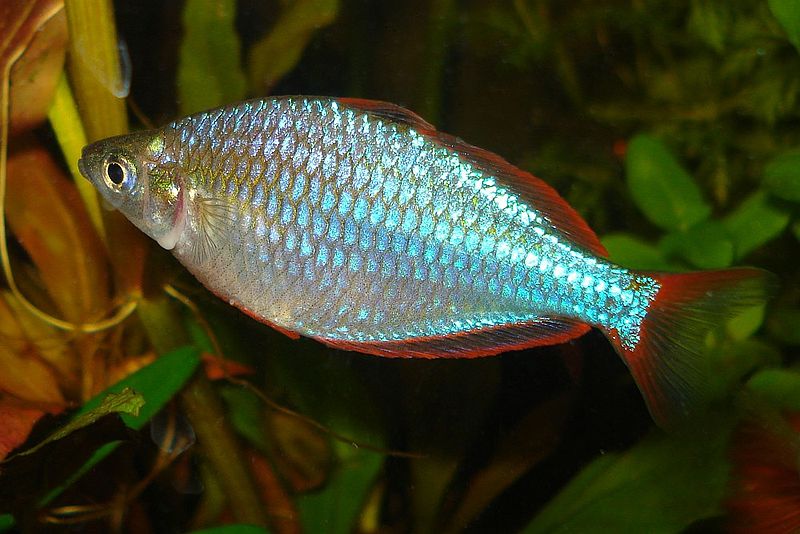
A smaller species of Rainbowfish, known for its bright, neon-like colors.
Glossolepis incisus (Red Rainbowfish)
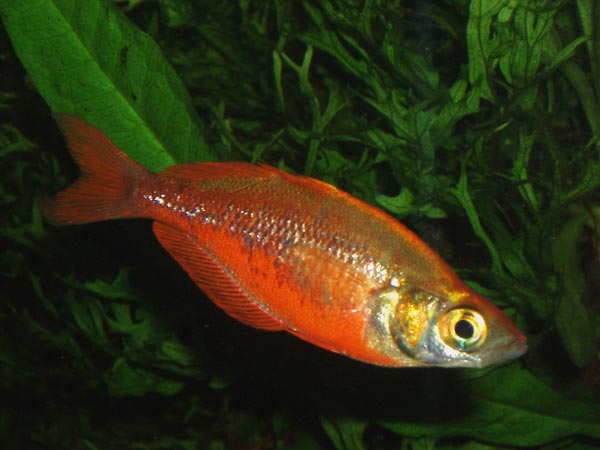
Also known as the Salmon-Red Rainbowfish, this species is known for its striking red coloration.
Melanotaenia herbertaxelrodi (Lake Tebera Rainbowfish)
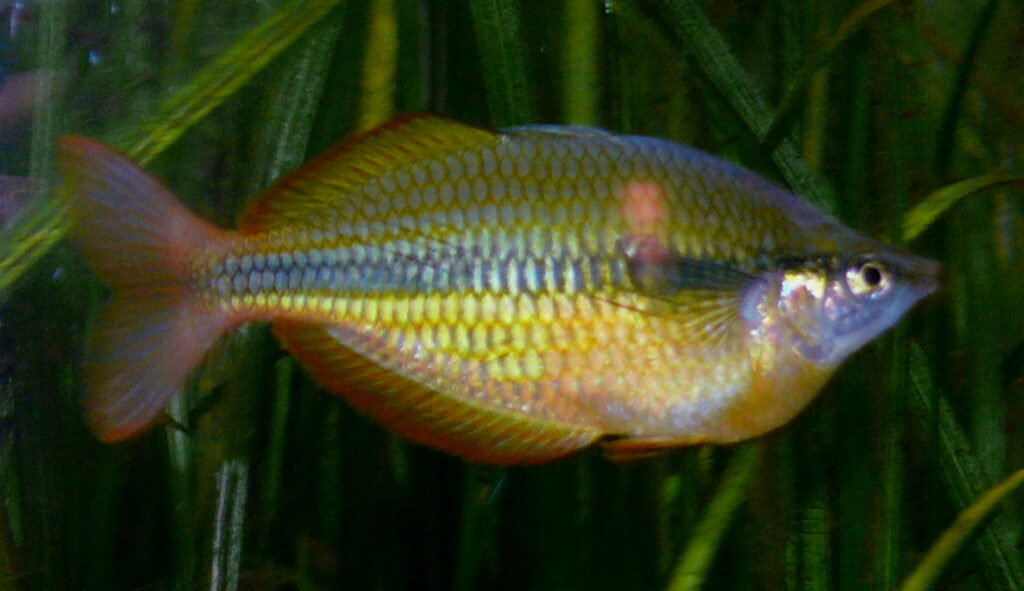
This species is named after its native habitat, Lake Tebera in Papua New Guinea. It’s also known as the Yellow Rainbowfish due to its bright yellow coloration.
Melanotaenia splendida (Eastern Rainbowfish)
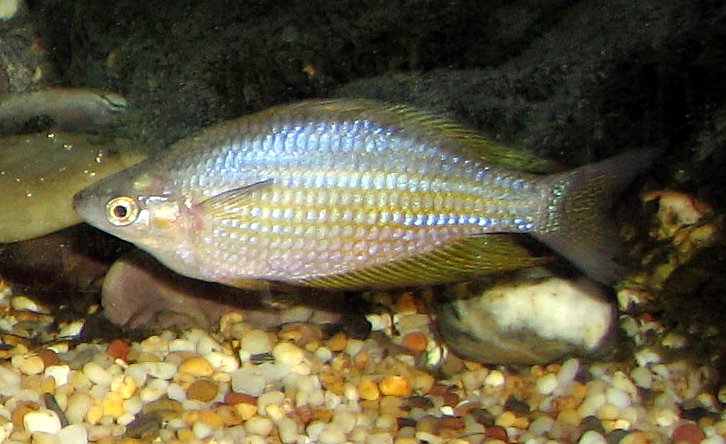
This species is known for its vibrant colors, which can range from blue to green to red, depending on the light and the fish’s mood.
Melanotaenia maccullochi (MacCulloch’s Rainbowfish)
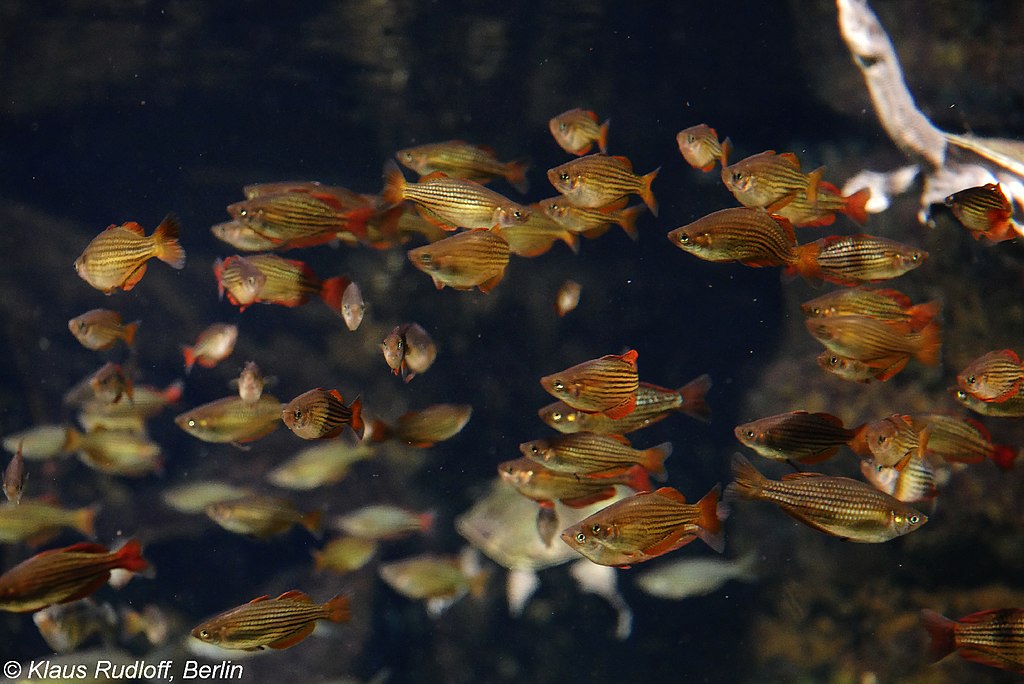
A smaller species with a peaceful temperament, known for its silvery-blue coloration with a hint of orange on the fins.
Chilatherina bleheri (Bleher’s Rainbowfish)
Named after the famous fish collector Heiko Bleher, this species is known for its beautiful blue and yellow coloration.
Iriatherina werneri (Threadfin Rainbowfish)
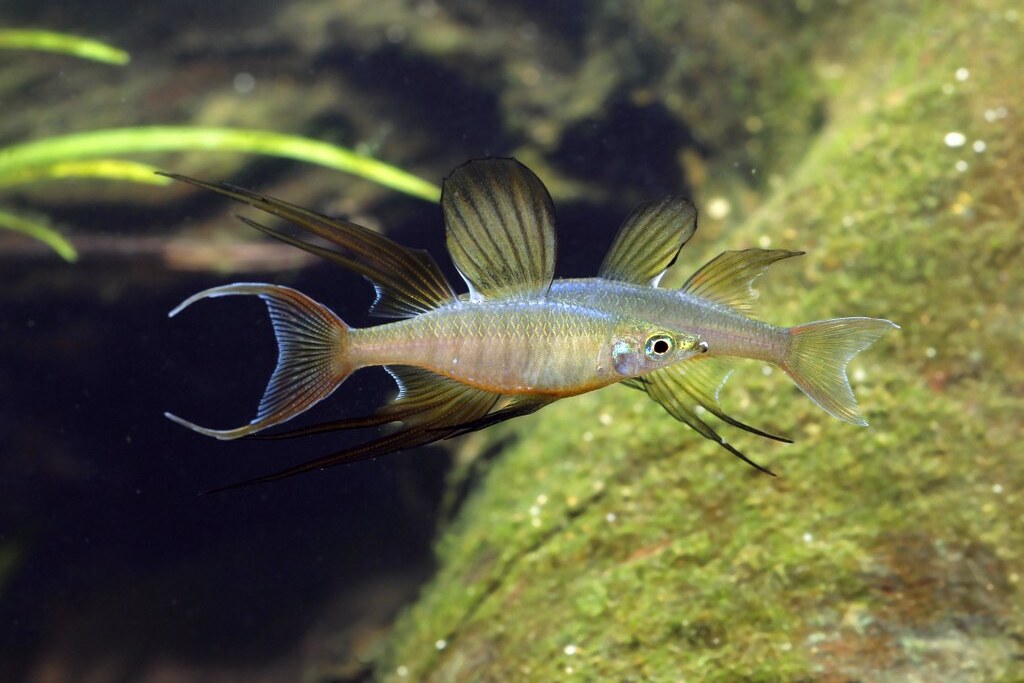
This species is known for its long, thread-like fins and peaceful nature. It has a silvery body with hints of yellow and blue.
Pseudomugil furcatus (Forktail Blue-eye Rainbowfish)
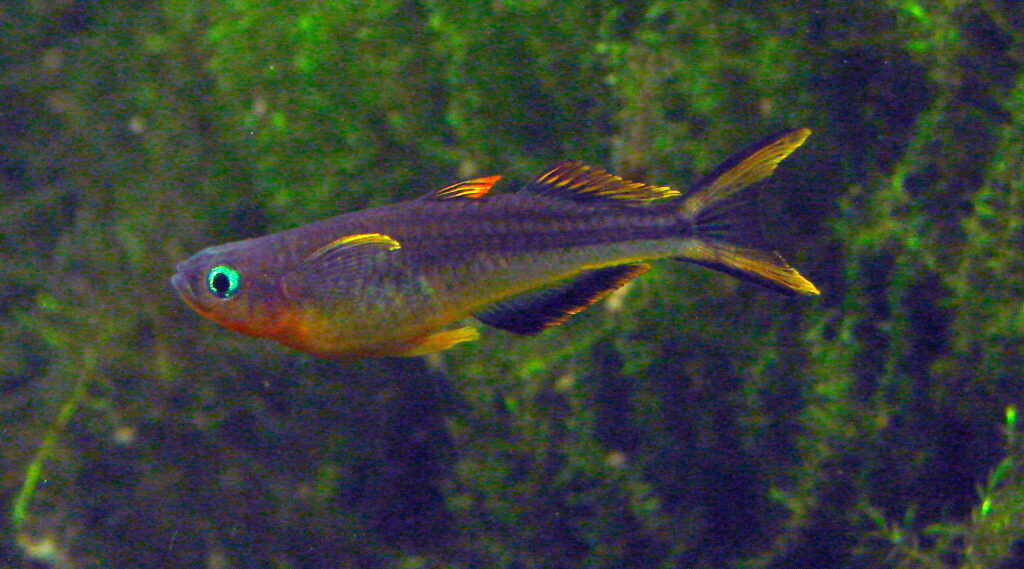
This small species is known for its bright blue eyes and forked tail. It has a yellowish body with blue and black stripes on the fins.
Each variant of Rainbowfish brings its own unique splash of color to the aquarium, making them a favorite among hobbyists. Whether you’re drawn to the vibrant hues of the Boeseman’s Rainbowfish or the smaller, neon colors of the Dwarf Neon Rainbowfish, there’s a Rainbowfish out there for every aquarium enthusiast.
Tank Size and Water Parameters for Rainbowfish
Rainbowfish are active swimmers and require a suitable environment to thrive. Here’s a detailed look at the recommended tank size and water parameters for Rainbowfish:
Tank Size
The size of the tank required for Rainbowfish largely depends on the species. However, as a general rule, a minimum of 20 gallons is recommended for smaller species. Larger species and those that prefer to live in schools will require a larger tank, typically 30-50 gallons or more. Remember, Rainbowfish are active swimmers and will appreciate as much space as you can provide.
Water Temperature
Rainbowfish are tropical freshwater fish and prefer warmer water temperatures. The ideal temperature range for most Rainbowfish is between 74-78°F (23-26°C). Consistent temperatures are important, so a reliable aquarium heater is recommended.
pH Level
Rainbowfish prefer slightly acidic to neutral water conditions. The ideal pH range is between 6.5 and 7.5. Regular water testing is important to ensure pH levels remain stable.
Water Hardness
Rainbowfish can tolerate a range of water hardness, but generally prefer moderately hard water. The ideal hardness range is between 8-12 dGH (degrees of general hardness).
Water Quality
Like all fish, Rainbowfish require clean, well-filtered water. Regular water changes (typically 25-50% per week) and a good filtration system are essential to remove waste and prevent the buildup of harmful chemicals.
Lighting
Rainbowfish do not have specific lighting needs, but a moderate level of lighting will help to show off their vibrant colors. If you have live plants in your aquarium, you’ll need to consider their lighting needs as well.
Current
In their natural habitat, Rainbowfish are used to living in streams and rivers with a moderate current. While they don’t require a strong current in the aquarium, they do appreciate some water movement. This can be achieved with a good filtration system or a powerhead.
Lifespan and Full Size of Rainbowfish
Understanding the lifespan and full size of Rainbowfish is crucial for their proper care and maintenance. Here’s a detailed look at these aspects:
Lifespan
On average, Rainbowfish live between 5 to 8 years in a well-maintained aquarium. However, some species can live even longer with optimal care. The lifespan of a Rainbowfish can be influenced by several factors including diet, water quality, stress levels, and genetics. Regular water changes, a balanced diet, and a stress-free environment can contribute to a longer lifespan.
Full Size
The size of a Rainbowfish at maturity can vary greatly depending on the species. On average, most Rainbowfish grow between 2 to 4 inches in length. However, some larger species like the Boeseman’s Rainbowfish can reach up to 6 inches in length. It’s important to note that males are typically larger and more colorful than females.
Growth Rate
Rainbowfish have a moderate growth rate. With proper care and a balanced diet, they can reach their full size within a year. Young Rainbowfish should be fed a high-quality diet rich in protein to support their growth.
Size in Relation to Tank Size
The size of your Rainbowfish should be considered when choosing a tank. As active swimmers, they need plenty of space to move around. A general rule of thumb is to provide at least 1 gallon of water for every inch of fish. However, more space is always better.
Size Differences Among Species
There is a significant size difference among Rainbowfish species. For instance, the Dwarf Neon Rainbowfish, as the name suggests, is a smaller species that typically grows to around 2 inches. On the other hand, the Boeseman’s Rainbowfish, one of the larger species, can grow up to 6 inches.
Natural Environment, Behavior, Habitat Preference, and Aquarium Decoration for Rainbowfish
Rainbowfish are fascinating creatures with specific preferences for their environment and habitat. Here’s a detailed look at these aspects:
Natural Environment
Rainbowfish are native to the freshwater rivers and streams of northern and eastern Australia, New Guinea, and a few islands in Indonesia and Madagascar. These environments are typically warm, slightly acidic to neutral, and have a moderate current.
Behavior
Rainbowfish are known for their active and peaceful behavior. They are schooling fish, meaning they prefer to live in groups and are often seen swimming together in the aquarium. They are mid to top-dwelling fish, often seen near the water’s surface.
Habitat Preference
In their natural habitat, Rainbowfish are often found in densely planted areas with plenty of hiding spots. They prefer areas with a moderate current, which mimics the flowing rivers and streams they are native to.
Aquarium Decoration
Creating a natural and comfortable environment for your Rainbowfish involves the use of various aquarium decorations. Here’s a detailed look at the types of decorations suitable for a Rainbowfish tank:
- Live Plants: Rainbowfish come from environments rich in vegetation. Including live plants in your aquarium not only adds to the aesthetic appeal but also provides hiding spots and reduces stress for the fish. Plants like Java Fern, Anubias, and Vallisneria are great choices.
- Rocks: Rocks can be used to create caves and hiding spots for Rainbowfish. They also add a natural look to the aquarium. Make sure to use aquarium-safe rocks that won’t affect the water chemistry.
- Driftwood: Driftwood is another excellent addition to a Rainbowfish tank. It provides hiding spots and also contributes to a natural-looking environment. Over time, driftwood can release tannins into the water, slightly lowering the pH, which can be beneficial for Rainbowfish.
- Substrate: A darker substrate can help enhance the vibrant colors of Rainbowfish. Sand or fine gravel is a good choice as it mimics their natural environment and is safe for the fish.
- Background: Using a background can help your fish feel more secure and can also hide equipment like heaters and filters. A natural-looking background can enhance the overall look of the aquarium.
- Caves and Hideouts: In addition to rocks and driftwood, you can also use specially designed caves and hideouts available in pet stores. These can provide additional shelter for your Rainbowfish.
- Aquatic Moss: Aquatic mosses like Java Moss can be a great addition to your Rainbowfish tank. They provide additional cover and can also be a place for Rainbowfish to spawn.
While decorating your aquarium, ensure there’s enough open space for Rainbowfish to swim freely. Also, all decorations should be thoroughly cleaned and safe for aquarium use.
Lighting and Substrate
Moderate lighting is recommended for Rainbowfish, as it helps to show off their vibrant colors. A darker substrate can also help to enhance their coloration.
Water Movement
As mentioned earlier, Rainbowfish appreciate some water movement in their tank, which can be achieved with a good filtration system or a powerhead.
Tank Mates and Fish to Avoid for Rainbowfish
Choosing the right tank mates for your Rainbowfish is crucial to maintain a peaceful and harmonious aquarium environment. Here’s a detailed look at suitable tank mates and fish to avoid:
Suitable Tank Mates
Rainbowfish are peaceful and get along well with most other community fish. Here are some species that make good tank mates for Rainbowfish:
- Neon Tetras: Small, peaceful, and brightly colored, Neon Tetras make a great addition to a Rainbowfish tank.
- Cardinal Tetras: Similar to Neon Tetras but with more vibrant colors, Cardinal Tetras are a great match for Rainbowfish.
- Rasboras: Small, peaceful, and schooling, Rasboras like the Harlequin Rasbora can coexist well with Rainbowfish.
- Corydoras Catfish: These bottom-dwelling fish are peaceful and can help clean the tank by eating leftover food.
- Kribensis Cichlids: A small and generally peaceful Cichlid species, Kribensis can be a good match for Rainbowfish.
- Guppies: Known for their vibrant colors and peaceful nature, Guppies can coexist well with Rainbowfish.
- Platies: Platies are peaceful, hardy, and come in a variety of colors, making them a good choice for a community tank with Rainbowfish.
- Mollies: Mollies are peaceful and easy to care for, making them a good match for Rainbowfish.
- Swordtails: Known for the males’ distinctive tail, Swordtails are peaceful and can coexist well with Rainbowfish.
- Dwarf Gouramis: These peaceful and colorful fish can make a great addition to a Rainbowfish tank.
- Cherry Barbs: Cherry Barbs are peaceful, easy to care for, and their red coloration can complement the colors of Rainbowfish.
- Zebra Danios: These are hardy, active, and peaceful fish that can coexist well with Rainbowfish.
- Ghost Shrimp: These small crustaceans are peaceful and can help keep the tank clean by eating leftover food.
- Amano Shrimp: Amano Shrimp are peaceful, hardy, and excellent cleaners, making them a good choice for a Rainbowfish tank.
- Nerite Snails: These snails are peaceful, hardy, and excellent at algae control.
- Bristlenose Plecos: These bottom-dwelling fish are peaceful and can help keep the tank clean by eating algae.
- Otocinclus Catfish: Known as “Otos,” these small catfish are peaceful and excellent at algae control.
- Endler’s Livebearers: These small, colorful, and peaceful fish can coexist well with Rainbowfish.
- Black Skirt Tetras: These are peaceful, schooling fish that can make a great addition to a Rainbowfish tank.
- White Cloud Mountain Minnows: These are small, hardy, and peaceful fish that can tolerate a wide range of temperatures.
Fish to Avoid
While Rainbowfish are generally peaceful, there are some types of fish that should not be kept with them:
- Aggressive Species: Fish that are known to be aggressive or territorial, such as some types of Cichlids, should be avoided.
- Large Predatory Fish: Fish that are large enough to see Rainbowfish as food should not be kept in the same tank. This includes species like Oscars or large Catfish.
- Fin Nippers: Species known for fin nipping, such as Tiger Barbs, should be avoided as they can cause stress and injury to Rainbowfish.
Considerations
When choosing tank mates for your Rainbowfish, consider the size, temperament, and environmental needs of all species in the tank. All fish should have similar water parameter requirements and enough space to exhibit their natural behaviors.
By carefully selecting compatible tank mates, you can create a diverse and harmonious community aquarium with Rainbowfish.
Best Foods/Diet for Rainbowfish
Rainbowfish are omnivores and require a varied diet to stay healthy and vibrant. Here’s a detailed look at the best foods and diet for Rainbowfish:
- Flake Foods: High-quality flake foods should be the staple of your Rainbowfish’s diet. They are nutritionally balanced and easy for the fish to eat.
- Pellets: Pellets are another good option for Rainbowfish. They are often more nutrient-dense than flakes and can be a good way to provide your fish with the essential nutrients they need.
- Live Foods: Live foods like brine shrimp, daphnia, and bloodworms are a great treat for Rainbowfish. They mimic the natural diet of Rainbowfish and can help enhance their coloration.
- Frozen Foods: Frozen foods like bloodworms, brine shrimp, and daphnia are good alternatives to live foods. They are easy to store and can provide your Rainbowfish with a good source of protein.
- Vegetables: Rainbowfish can also benefit from the occasional serving of blanched vegetables like peas, spinach, and zucchini. These provide important vitamins and fiber.
- Vitamin Supplements: Adding a vitamin supplement to your Rainbowfish’s diet can help ensure they are getting all the nutrients they need. These can usually be added to the water or mixed with their food.
- Feeding Schedule: Rainbowfish should be fed 1-2 times per day. Only provide as much food as they can eat in 2-3 minutes to prevent overfeeding and water pollution.
- Diet Variation: Providing a varied diet is important for the health and coloration of Rainbowfish. Try to offer a mix of different foods to provide a range of nutrients.
Breeding Tips for Rainbowfish
Breeding Rainbowfish can be a rewarding experience for any aquarium hobbyist. Here’s a detailed look at some tips for successful Rainbowfish breeding:
- Sexual Maturity: Rainbowfish typically reach sexual maturity between 9 months to a year of age. Males are usually larger and more colorful than females.
- Breeding Tank: Set up a separate breeding tank with similar water parameters to the main tank. A 10-20 gallon tank is usually sufficient. The breeding tank should be quiet and have plenty of plants or spawning mops for the fish to lay their eggs on.
- Spawning Mops: Spawning mops are bundles of yarn or synthetic material that mimic the dense vegetation Rainbowfish use for spawning in the wild. They provide a place for Rainbowfish to deposit their eggs.
- Diet: Feed your Rainbowfish a high-quality, varied diet to condition them for breeding. This should include live or frozen foods such as brine shrimp or daphnia.
- Water Conditions: Maintain optimal water conditions in the breeding tank. The water should be clean, well-oxygenated, and within the correct temperature and pH range for Rainbowfish.
- Egg Care: After spawning, Rainbowfish eggs should be carefully removed from the breeding tank and placed into a separate tank to hatch. This prevents the adult fish from eating the eggs.
- Fry Care: Once the eggs hatch, the fry can be fed infusoria or commercially available fry foods until they are large enough to eat brine shrimp nauplii or finely crushed flake food.
- Patience: Breeding Rainbowfish requires patience. It may take several attempts before you see success. Don’t be discouraged if your first few attempts don’t result in any fry.
FAQs
Are Rainbowfish good for beginners?
Yes, Rainbowfish are a good choice for beginners. They are hardy, peaceful, and easy to care for. However, they do require a larger tank than some other beginner fish due to their active swimming habits.
How many Rainbowfish should be kept together?
Rainbowfish are schooling fish and prefer to be kept in groups. A minimum of 6 is often recommended, but they will be happier and more secure in larger groups.
Why are my Rainbowfish losing color?
Rainbowfish can lose color due to stress, poor diet, illness, or poor water conditions. If your Rainbowfish are losing color, it’s important to check your water parameters and ensure they are receiving a varied and nutritious diet.
Can Rainbowfish live in a planted tank?
Yes, Rainbowfish thrive in planted tanks. In their natural habitat, they are often found in densely planted areas. Live plants in the aquarium provide hiding spots, reduce stress, and mimic their natural environment.
Do Rainbowfish jump?
Yes, Rainbowfish are known to be jumpers, especially when they are stressed or scared. It’s recommended to have a well-fitted lid on your aquarium to prevent them from jumping out.
What diseases are Rainbowfish prone to?
Like all fish, Rainbowfish can be susceptible to a variety of diseases, including Ich, fin rot, and fungal infections. Maintaining good water quality, providing a balanced diet, and promptly treating any visible signs of illness can help keep your Rainbowfish healthy.
Can Rainbowfish change color?
Yes, Rainbowfish can change color based on their mood, health, and environmental conditions. For example, their colors can become more vibrant during breeding, or they may lose color if they are stressed or ill.
Are Rainbowfish aggressive?
No, Rainbowfish are not typically aggressive. They are peaceful fish that get along well with other community fish. However, like all fish, they can show signs of aggression if they are stressed, overcrowded, or not provided with enough resources.
Do Rainbowfish need a heater?
Yes, as tropical freshwater fish, Rainbowfish prefer warmer water temperatures. A reliable aquarium heater is recommended to maintain consistent temperatures in the range of 74-78°F (23-26°C).
Can Rainbowfish live in a community tank?
Yes, Rainbowfish are excellent community fish due to their peaceful nature. They can coexist well with a variety of other peaceful fish species. However, it’s important to ensure all species in the tank have similar water parameter requirements and enough space to exhibit their natural behaviors.